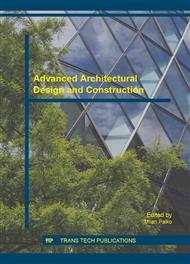[1]
Chmúrny I.: Thermal protection of buildings. Publishers Jaga group, v. o. s., Bratislava, (2003).
Google Scholar
[2]
Hauser, G. – Kempkes, Ch.: Der Einfluss von windinduzierten Druckschwankungen auf das thermisch-hygrische Verhalten von durchstromten Leckagen. Kassel, (2005).
Google Scholar
[3]
Hens, H.: Building Physics – Heat, Air and Moisture. Fundamentals and Engineering Methods with Examples and Exercises. Berlin: Ernst &Sohn A Wiley Company, 2007. ISBN 978-3-433-01841-5.
DOI: 10.1002/9783433602379
Google Scholar
[4]
Palko, M., - Ďurinová, A.: Effect of airflow on the thermal-technical properties of building envelope. In: 31. International Scientific Conference departments and institutes civil engineering conference. Čeladná, (2007).
Google Scholar
[5]
Palková, A., Palko, M. Condensation of water vapour in the window structure In: Zborník z ANSYS konference 2010, Frymburk, 2010 , ISBN: 978-80-254-8388-6.
Google Scholar
[6]
Palková,A., Palko,M.: Condensation of water vapour in the inner cavity window. In: Proceedings of the Conference ANSYS 2009, Plzeň 23. -25. 9. 2009, ISBN: 978-80-254-5437-4.
Google Scholar
[7]
Oravec P. Windows in Buildings - Diagnostics of Selected Properties after Time of Using. Advanced Materials Research. 2014; vol. 899, pp.184-187. DOI: 10. 4028/www. scientific. net.
DOI: 10.4028/www.scientific.net/amr.899.184
Google Scholar
[8]
ORAVEC, P., Insulating windows with integrated frame from composite material, In 2nd International Materials, Industrial and Manufacturing Engineering Conference (MIMEC 2015), p.374, Universiti Teknologi Malaysia (2015).
DOI: 10.1016/j.promfg.2015.07.061
Google Scholar


